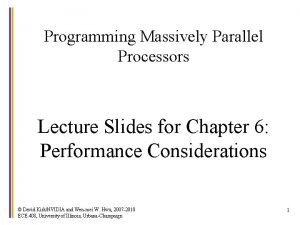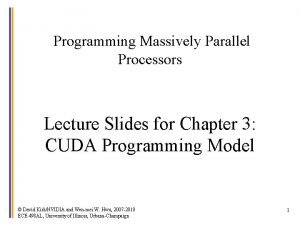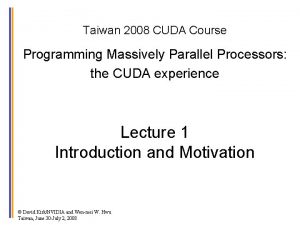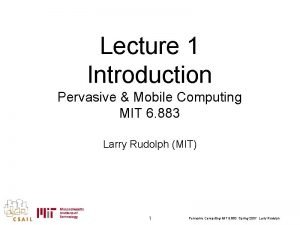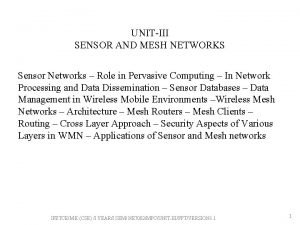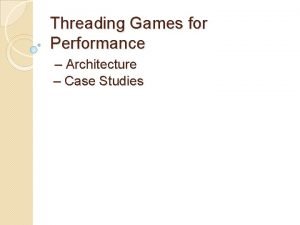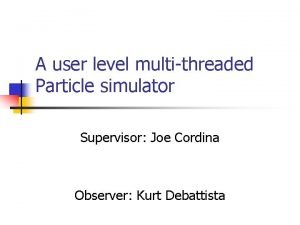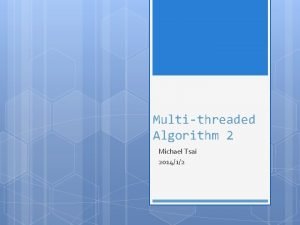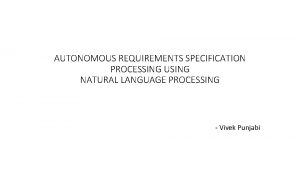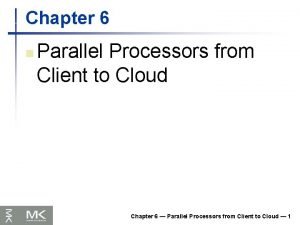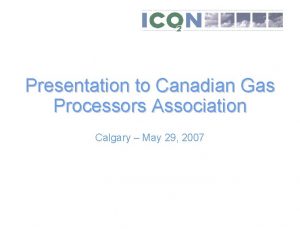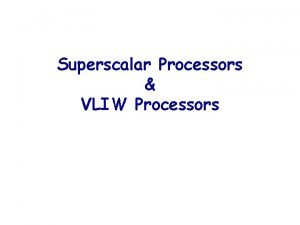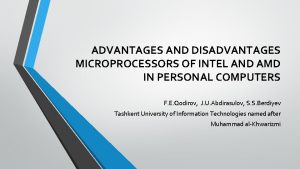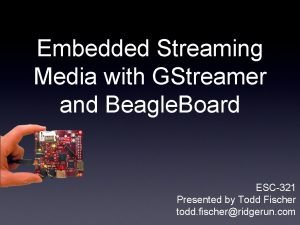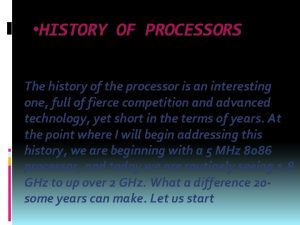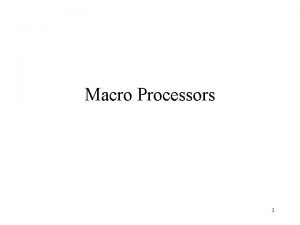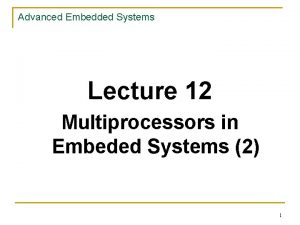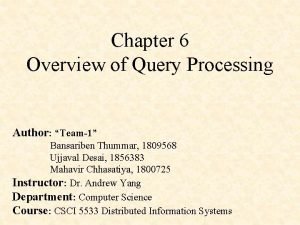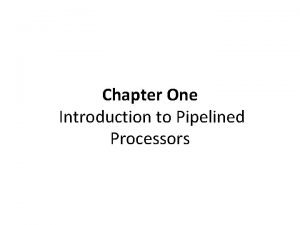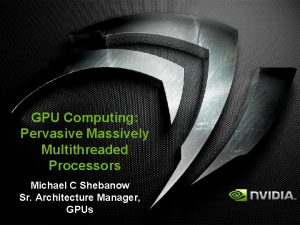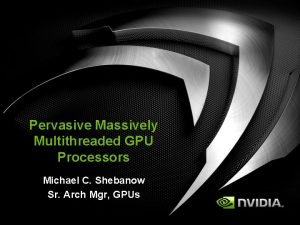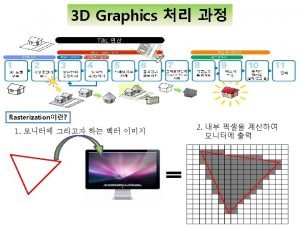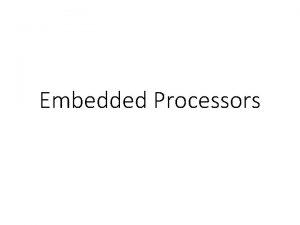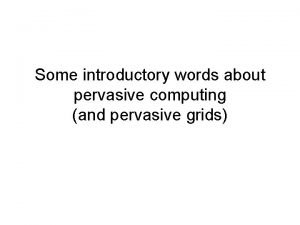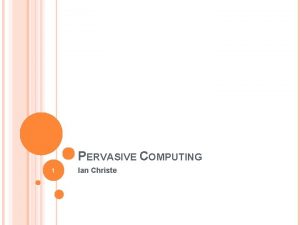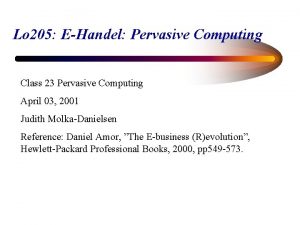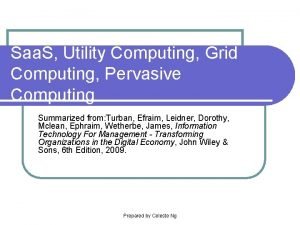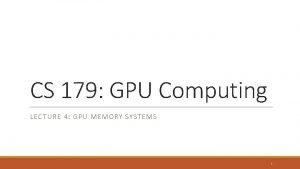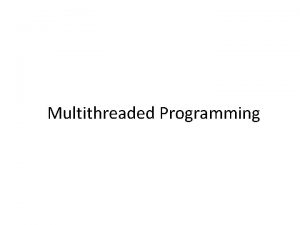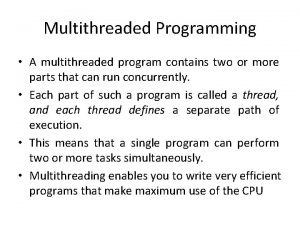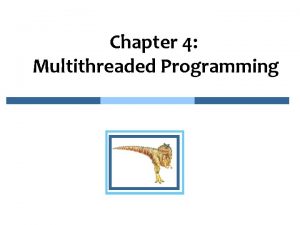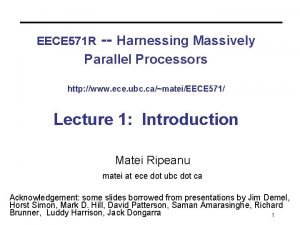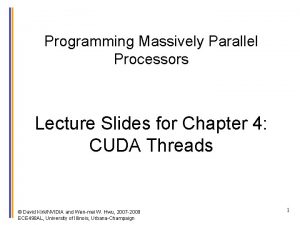GPU Computing Pervasive Massively Multithreaded Processors Michael C









































- Slides: 41

GPU Computing: Pervasive Massively Multithreaded Processors Michael C Shebanow Sr. Architecture Manager, GPUs

Agenda ● ● ● GPU Computing Tesla Products CUDA SM: Thread Multiprocessor Application Performance Model © NVIDIA Corporation 2008

GPU Computing ● GPU = graphics processing unit ● NVIDIA’s latest ● products = 88 xx/98 xx series Accelerates Graphics ● GPU Computing ● Using GPUs for general purpose computing other than graphics © NVIDIA Corporation 2008

GPU Computing is Pervasive ● Huge #s of deployed parallel computing engines ● ● ● NVIDIA has shipped >70 M CUDA-capable GPUs to date NVIDIA currently shipping more than 1 M CUDAcapable GPUs per week Wide range of products ranging from laptops to the servers ● Coming soon: cell phones, PDAs, … © NVIDIA Corporation 2008

GPU Computing Key Concepts ● ● ● Hardware (HW) thread management ● ● HW thread launch and monitoring HW thread switching Tens of thousands of lightweight, concurrent threads Real threads: PC, private registers, … SIMT execution model Multiple memory scopes ● ● ● Per-thread private memory Per-thread-block shared memory Global memory Using threads to hide memory latency Coarse grain thread synchronization © NVIDIA Corporation 2008

SIMT Multithreaded Execution ● SIMT: Single-Instruction Multi-Thread executes one instruction across many independent threads ● Single-Instruction Multi-Thread instruction scheduler ● time warp 8 instruction 11 ● Hardware implements zero-overhead warp and thread scheduling ● SIMT threads can execute independently warp 1 instruction 42 warp 3 instruction 95. . . warp 8 instruction 12 warp 3 instruction 96 © NVIDIA Corporation 2008 Warp: a set of 32 parallel threads that execute a SIMT instruction SIMT provides easy single-thread scalar programming with SIMD efficiency ● ● SIMT warp diverges and converges when threads branch independently Best efficiency and performance when threads of a warp execute together

Multiple Memory Scopes ● Per-thread private memory Thread ● ● ● Per-thread-block shared memory ● ● ● Each thread has its own local memory Stacks, other private data Block Per-block Shared Memory Small memory close to the processor, low latency Allocated per thread block Main memory ● ● Per-thread Local Memory GPU frame buffer Can be accessed by any thread in any thread block © NVIDIA Corporation 2008 Kernel 0 Kernel 1 . . . Sequential Blocks Per-device Global Memory

Hiding LOAD Latency ● ● Principle: Little’s Law: ● ● ● Arrival Rate product of: ● ● ● N = “number in flight” l = arrival rate L = memory latency Desired execution rate (IPC) Density of LOAD instructions (%) N = # of threads needed to cover latency L W 0 T 0 Load Req W 0 T 1 Load Req W 0 T 2 Load Req W 0 T 0 Load Resp W 0 T 1 Load Resp W 0 T 2 Load Resp Wk. T 29 Load Req Wk. T 30 Load Req Wk. T 31 Load Req Time © NVIDIA Corporation 2008

Hiding LOAD Latency w/ Fewer Threads ● Use batching ● Group independent ● LOADs together Modified law: // batch size 3 example float *d_A, *d_B, *d_C; float a, b, c, result; a = *d_A; b = *d_B; c = *d_C; result = a * b + c; ● ● ● B = batch size © NVIDIA Corporation 2008 The values ‘a’, ‘b’, and ‘c’ are loaded independently before being used Implication is that we can execute 3 loads from one thread before the first use (‘a’ in this case) causes a stall

Thread Synchronization ● Barrier synchronization among threads of block ● ● ● Fast single-instruction barrier in Tesla GPUs void __syncthreads(); Synchronizes all threads in a thread block Once all threads have reached this point, kernel execution resumes normally Use before reading shared memory written by another thread in the same block Global synchronization between dependent kernels ● ● Waits for all thread blocks of kernel grid to complete Fast synchronization and kernel launch in Tesla GPUs © NVIDIA Corporation 2008 10

Tesla Series Products

The Tesla 8 -Series Processor NVIDIA’s 1 st Generation CUDA Processor ● 681 million ● ● transistors 518 Gigaflops 128 cores (SPs), 12288 threads max 384 -bit 800 MHz GDDR 3 76 GB/sec peak © NVIDIA Corporation 2008

The Tesla 10 -Series Processor NVIDIA’s 2 nd Generation CUDA Processor ● 1. 4 billion ● ● transistors 1 Teraflop 240 cores (SPs), 30720 threads max 512 -bit, 800 MHz GDDR 3 102 GB/sec peak © NVIDIA Corporation 2008

Tesla C 1060 Computing Processor © NVIDIA Corporation 2008 Processor 1 x Tesla T 10 Number of cores 240 Core Clock 1. 33 GHz On-board memory 4. 0 GB Memory bandwidth 102 GB/sec peak Memory I/O 512 -bit, 800 MHz GDDR 3 Form factor Full ATX: 4. 736” x 10. 5” Dual slot wide System I/O PCIe x 16 Gen 2 Typical power 160 W

Tesla S 1070 1 U System © NVIDIA Corporation 2008 Processors 4 x Tesla T 10 Number of cores 960 Core Clock 1. 5 GHz Performance 4 Teraflops Total system memory 16. 0 GB (4. 0 GB per T 10) Memory bandwidth 408 GB/sec peak (102 GB/sec per T 10) Memory I/O 2048 -bit, 800 MHz GDDR 3 (512 -bit per T 10) Form factor 1 U (EIA 19” rack) System I/O 2 PCIe x 16 Gen 2 Typical power 700 W

Example Speedups 146 X 36 X Interactive visualization of volumetric white matter connectivity Ionic placement for molecular dynamics simulation on GPU 149 X 47 X Financial simulation of LIBOR model with swaptions © NVIDIA Corporation 2008 GLAME@lab: An M-script API for linear Algebra operations on GPU 17 X 100 X Simulation in Matlab using. mex file CUDA function Astrophysics Nbody simulation 20 X 24 X 30 X Ultrasound medical imaging for cancer diagnostics Highly optimized object oriented molecular dynamics Cmatch exact string matching to find similar proteins and gene sequences 18 X Transcoding HD video stream to H. 264

Example: Fluid Simulation CUDA port of: Jos Stam, "Stable Fluids", In SIGGRAPH 99 Conference Proceedings, Annual Conference Series, August 1999, 121 -128. © NVIDIA Corporation 2008

CUDA N-Body Simulation 10 B interactions / s 16 K bodies 44 FPS x 20 FLOPS / interaction x 16 K 2 interactions / frame = 240 GFLOP/s = 50 x tuned CPU implementation on Intel Core 2 Duo Ge. Force 8800 GTX GPU Highly Parallel High Arithmetic Intensity © NVIDIA Corporation 2008

N-Body Physics on CUDA ● ● All-pairs gravitational N-body physics of 16, 384 stars 240 GFLOPS on NVIDIA Ge. Force 8800 – see GPU Gems 3 © NVIDIA Corporation 2008

CUDA

CUDA Programming Model ● ● Minimal extension of C and C++ languages Write a serial program that calls parallel kernels NVCC Serial portions execute on the host CPU A kernel executes as parallel threads on the GPU device ● ● Kernels may be simple functions or full programs Many threads execute each kernel © NVIDIA Corporation 2008 Virtual C CUDA Application CPU Code PTX Code Physical PTX to Target Compiler G 80 … Target code GTX

CUDA Thread Model ● Thread Block t 0 t 1 t 2 … tm ● ● Grid Thread ● ● Computes result elements thread. Idx is thread id number Thread Block ● ● ● Computes result data Block 1 to 512 threads per Thread Block block. Idx is block id number Grid of Blocks ● ● Computes many result blocks 1 to many blocks per grid Sequential Grids ● Compute sequential problem steps Block 0 Block 1 Block 2 Block n . . . © NVIDIA Corporation 2008

CUDA: Basics ● Declaration specifiers to indicate where things live __global__ __device__ device __device__ memory __shared__ memory ● void Kernel. Func(. . . ); void Device. Func(. . . ); // kernel callable from host // function callable on int Global. Var; // variable in device int Shared. Var; // in per-block shared Extend function invocation syntax for parallel kernel launch Kernel. Func<<<500, 128>>>(. . . ); each ● Special variables for thread identification in kernels dim 3 thread. Idx; ● // 500 blocks, 128 threads dim 3 block. Idx; dim 3 block. Dim; Intrinsics that expose specific operations in kernel code __syncthreads(); © NVIDIA Corporation 2008 // barrier synchronization

CUDA: Extended Features ● Standard mathematical functions sinf, powf, atanf, ceil, etc. ● Built-in vector types float 4, int 4, uint 4, etc. for dimensions 1. . 4 ● Atomics atomic. Add(int *pmem; int value), etc. add, sub, min, max, and, or, xor. . . ● Texture accesses in kernels texture<float, 2> my_texture; // declare texture reference float 4 texel = texfetch(my_texture, u, v); © NVIDIA Corporation 2008

CUDA Memory Management // allocate host memory unsigned int num. Bytes = N * sizeof(float) float* h_A = (float*) malloc(num. Bytes); // allocate device memory float* d_A = 0; cuda. Malloc((void**)&d_A, numbytes); // copy data from host to device cuda. Memcpy(d_A, h_A, num. Bytes, cuda. Memcpy. Host. To. Device); // copy data from device back to host cuda. Memcpy(h_A, d_A, num. Bytes, cuda. Memcpy. Device. To. Host); // free device memory cuda. Free(d_A); © NVIDIA Corporation 2008 25

Example: Vector Addition Kernel Device Code // Compute vector sum C = A+B // Each thread performs one pair-wise addition __global__ void vec. Add(float* A, float* B, float* C) { int i = thread. Idx. x + block. Dim. x * block. Idx. x; C[i] = A[i] + B[i]; } int main() { // Run N/256 blocks of 256 threads each vec. Add<<< N/256, 256>>>(d_A, d_B, d_C); } © NVIDIA Corporation 2008

Example: Vector Addition Kernel // Compute vector sum C = A+B // Each thread performs one pair-wise addition __global__ void vec. Add(float* A, float* B, float* C) { int i = thread. Idx. x + block. Dim. x * block. Idx. x; C[i] = A[i] + B[i]; } Host int main() { // Run N/256 blocks of 256 threads each vec. Add<<< N/256, 256>>>(d_A, d_B, d_C); } © NVIDIA Corporation 2008 Code

Example: Host code for vec. Add // allocate and initialize host (CPU) memory float *h_A = …, *h_B = …; // allocate float *d_A, cuda. Malloc( device (GPU) memory *d_B, *d_C; (void**) &d_A, N * sizeof(float)); (void**) &d_B, N * sizeof(float)); (void**) &d_C, N * sizeof(float)); // copy host memory to device cuda. Memcpy( d_A, h_A, N * sizeof(float), cuda. Memcpy. Host. To. Device) ); cuda. Memcpy( d_B, h_B, N * sizeof(float), cuda. Memcpy. Host. To. Device) ); // execute the kernel on N/256 blocks of 256 threads each vec. Add<<<N/256, 256>>>(d_A, d_B, d_C); © NVIDIA Corporation 2008

Example #2: Adding matrices with 2 D grids CPU C program CUDA C program void add. Matrix(float *a, float *b, float *c, int N) { int i, j, index; for (i = 0; i < N; i++) { for (j = 0; j < N; j++) { index = i + j * N; c[index]=a[index] + b[index]; } } } __global__ void add. Matrix(float *a, float *b, float *c, int N) { int i=block. Idx. x*block. Dim. x+thread. Idx. x; int j=block. Idx. y*block. Dim. y+thread. Idx. y; int index = i + j * N; if ( i < N && j < N) c[index]= a[index] + b[index]; } void main() {. . . add. Matrix(a, b, c, N); } © NVIDIA Corporation 2008 void main() {. . . dim 3 dim. Blk (blocksize, blocksize); dim 3 dim. Grd (N/dim. Blk. x, N/dim. Blk. y); add. Matrix<<<dim. Grd, dim. Blk>>> (a, b, c, N); }

The SM: Thread Multiprocesor

Tesla 10 -Series Architecture ● ● Scales parallel performance 2 X beyond Tesla 8 -series 240 multithreaded thread processors at 1. 5 GHz, 1 TFLOPS peak © NVIDIA Corporation 2008

T 10 Multithreaded Multiprocessor ● ● ● © NVIDIA Corporation 2008 Scalar register-based ISA Multithreaded Instruction Unit ● ● 1024 threads, hardware multithreaded 32 SIMT warps of 32 threads Independent thread execution Hardware thread scheduling 8 SP Thread Processors ● ● ● IEEE 754 32 -bit floating point 32 -bit and 64 -bit integer 16 K 32 -bit registers 2 SFU Special Function Units ● ● ● RCP, RSQRT, EXP 2, LOG 2, SIN, COS 2 SFUs per SM yields ¼ instruction throughput Accuracy ranges from 22. 5 to 24. 0 bits 1 DP Double Precision Unit ● ● ● IEEE 754 64 -bit floating point Fused multiply-add Full-speed denormalized operands and results 16 KB Shared Memory ● ● Concurrent threads share data Low latency load/store

SM Conceptual Block Diagram © NVIDIA Corporation 2008

Application Performance

Limiter Theory ● ● ● SM a form of queuing system Use “limiter theory” to predict SM performance There are three types of limits on the performance of the SM: ● ● Bandwidth resource limiters Per-thread-block space limiters Per-thread space limiters The most constraining limiter is called the critical limiter ● = min(all limiters) © NVIDIA Corporation 2008

Bandwidth Limiters ● ● ● Thread blocks arrive at some rate λTB Threads composed of some distribution of operations Each arriving thread block of S threads contributes a distribution of operations to be performed Per operation type, the offered load, or BW DEMAND, is the product of: ● ● ● Thread block arrival rate λTB # of threads S in a block Operation density δ in each thread BW CAPACITY is an upper bound on BW DEMAND 2 // Compute vector sum C = A+B // Each thread performs one pair-wise addition __global__ void vec. Add(float* A, float* B, float* C) { int i = thread. Idx. x + block. Dim. x * block. Idx. x; C[i] = A[i] + B[i]; } © NVIDIA Corporation 2008 1 0 FADD IMUL LOAD STORE

Space Limiters ● SM also has space resources. Examples: ● ● Space resources: ● ● Finite limit on warp count Finite limit on register file space Finite limit on shared memory size Allocated on thread block launch Deallocated on thread block completion Consumption computed using Little’s Law (N = λL) Thread Latency (L) ● ● Complex computation Varies with memory behavior © NVIDIA Corporation 2008

Limitations of Limiter Theory ● Limiter theory ● ● assumes uniform workloads Breaks down if “traffic jam” behavior Limiter theory is an ok 1 st order approximation © NVIDIA Corporation 2008 // Compute vector sum C = A+B // Each thread performs one pair-wise addition __global__ void vec. Add(float* A, float* B, float* C) { int i = thread. Idx. x + block. Dim. x * block. Idx. x; C[i] = A[i] + B[i]; } 2 1 0 FADD IMUL LOAD STORE

Implications of Limiter Theory ● ● Kernel code has to pay careful attention to Operation “mix” ● ● ● Don’t “freeway jam” kernel code ● ● Math-to-memory operation ratios for example Do not want to bottleneck on one function unit leaving other units idling Ideal: all units equally critical Making thread blocks too large so that only a few execute on the SM at a time a bad idea “Bunching” operations of a similar type in one section of a kernel will aggravate the problem Ideal: lots of small thread blocks with uniform distribution of operation densities Focus on space resource consumption ● Ideal: use as few resources necessary to “load the SM” © NVIDIA Corporation 2008

Final Thoughts ● ● ● Threads are free ● ● ● A common mistake in GPU Computing kernels is to make threads do too much Keep them short and sweet Example: one thread per vector element HW provides LOTs of them (10 s of thousands) HW launch => near zero overhead to create them HW context switching => near zero overhead scheduling Barriers are cheap ● ● Single instruction HW synchronization of thread blocks Partition kernel code into producer-consumer DON’T use spin locks! Partition on results, not sources © NVIDIA Corporation 2008

Questions? MShebanow@nvidia. com http: //www. nvidia. com/CUDA http: //www. nvidia. com/TESLA
 Programming massively parallel processors
Programming massively parallel processors Massively parallel processing ppt
Massively parallel processing ppt Programming massively parallel processors, kirk et al.
Programming massively parallel processors, kirk et al. Programming massively parallel processors
Programming massively parallel processors Mobile computer wikipedia
Mobile computer wikipedia Pervasive and mobile computing
Pervasive and mobile computing Pervasive and mobile computing
Pervasive and mobile computing Pervasive computing ppt
Pervasive computing ppt Mobile and pervasive computing
Mobile and pervasive computing Matlab parallel computing gpu
Matlab parallel computing gpu Best gpu for scientific computing
Best gpu for scientific computing Multithreaded languages
Multithreaded languages Real time example of multithreading in java
Real time example of multithreading in java Multithreaded games
Multithreaded games Apt multithreaded
Apt multithreaded Multithreaded algorithms
Multithreaded algorithms X-trace: a pervasive network tracing framework
X-trace: a pervasive network tracing framework Pdd
Pdd Pervasive integration
Pervasive integration Pseudodementia
Pseudodementia Primary and secondary stakeholders
Primary and secondary stakeholders Pddst
Pddst Conventional computing and intelligent computing
Conventional computing and intelligent computing Language and processors for requirement
Language and processors for requirement Parallel processors from client to cloud
Parallel processors from client to cloud Difference between linear and non linear pipeline
Difference between linear and non linear pipeline Recursive macro expansion
Recursive macro expansion Microcontrollers and embedded processors
Microcontrollers and embedded processors Digital camera processors
Digital camera processors Difference lan wan
Difference lan wan Gas processors association
Gas processors association Aicarm
Aicarm Difference between vliw and superscalar processor
Difference between vliw and superscalar processor Comparison of word processors
Comparison of word processors Amd processor disadvantages
Amd processor disadvantages Gstreamer architecture
Gstreamer architecture The history of cpu
The history of cpu Macro instruction
Macro instruction Embeded processors
Embeded processors Characterization of query processors
Characterization of query processors Ece 526
Ece 526 Handlers classification in parallel computing
Handlers classification in parallel computing
